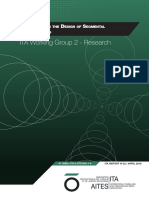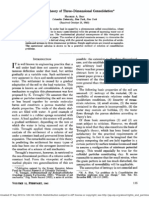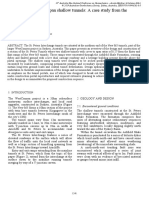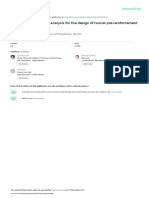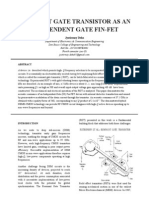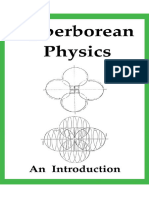Discussion Muir Wood Circular Tunnel in Elastic Ground
Discussion Muir Wood Circular Tunnel in Elastic Ground
Uploaded by
Ammar SohailCopyright:
Available Formats
Discussion Muir Wood Circular Tunnel in Elastic Ground
Discussion Muir Wood Circular Tunnel in Elastic Ground
Uploaded by
Ammar SohailCopyright
Available Formats
Share this document
Did you find this document useful?
Is this content inappropriate?
Copyright:
Available Formats
Discussion Muir Wood Circular Tunnel in Elastic Ground
Discussion Muir Wood Circular Tunnel in Elastic Ground
Uploaded by
Ammar SohailCopyright:
Available Formats
DISCUSSIONS
The circular tunnel in elastic ground
MUIR WOOD, A. M. (1975). Gt%technique 25, No. 1, 115127.
D. J. Curtis, Mott, Hay and Anderson, Croydon
Muir Wood presents a simple approach to the problem of proportioning tunnel linings,
which can be useful in many situations. A great amount of mathematical analysis is contained
in the Paper, and this contribution questions some of the assumptions and the accuracy of
some of the formulae. The extension of the method to include the parameter of time in
the context of visco-elastic behaviour of ground and lining is indicated, in a manner which
retains the simplicity desired by the Author.
NOTATION
The Author’s notation is followed wherever possible, but some variations and additional
symbols are employed. In general, a symbol with subscript c refers to ground behaviour,
whilst a symbol without this subscript refers to the lining. All stresses and displacement
described occur at the interface between ground and lining, at r=ro.
g gravitational acceleration Ul deformation of lining
H3 water head at radius r3 uo deformation of ground in absence of
N circumferential (hoop) thrust per unit a lining
length of lining ii deformation of ground inhibited by
PW pressure on lining due to water presence of a lining
Q Author’s compressibility factor R, Y rate of creep
Q2 analogous to the inverse of Author’s E strain
stiffness factor R,, expressed thus as P density of water
for a solid lining Qz= Qro2/t2 %, =h pre-existing vertical and horizontal
Qlr seepage factor stress in undisturbed ground
sn,St normal and shear stresses (%--%=Po)
TO time interval between excavation and ratio of uniaxial creep strain to
installation of lining immediate (elastic) strain
BENDING IN THE ELLIPTICAL MODE
Using Airy’s stress function, for a circular opening in an infinite ground, deformations at the
periphery of the opening can be obtained:
uo = w [(S - 6v)S,,+ (4-6v)S,,] cos 28 . . . . . (Al)
0
uoe = -r’$~+V)[(4-6~)S..+(5-6~)S,1sin 20 . . . . (A2)
c
where stresses S,, cos 20 and - S,, sin 28 act normally and tangentially around the opening.
When the opening is excavated, the distortional unloading of the ground is
PO
T cos 28
so that S,, = S,, = PO
T
Downloaded by [] on [06/11/21]. Copyright © ICE Publishing, all rights reserved.
232 DISCUSSIONS
The elastic, or immediate deformation of the ground is
uo. = ~(3-4v)+cos28 . . . . . . . (A3)
C
UOBO = -r”~+“)(3-4~)$sin28 . . . . . . . (A4)
C
A thin inextensible lining will deform
Ul = r,4(2S,+S,)cos 28/18EZ . . . . . . - (A5)
uel = -ro4(2sn+ S,> sin 28/18EZ . . . . . . . (A6)
producing forces in the lining
Z&$ (S,+2S,) c0s 28 . . . . . . . . (A7)
M = $(2Sn+S,)c0s 28 . . . . . . . . * WV
Making the Author’s assumption of no shear between lining and ground, (i.e. S,=O) we
proceed as follows.
(a) The ground will deform radially under the action of % cos 28 according to eqn (A3).
(b) The lining will deform radially under a load S, cos 28, from eqn (A5)
ul = gz2S., cos 28.
(c) The ground will be restrained from deforming radially under the action of a load
S,,, cos 28 = -S,, cos 28 from eqn (Al)
no = <~C(l+u)(5-6~)S. cos 28.
(d) Since u. +a0 = ul, we find
s = 3(3 - 4v)P,,/2 ...... (A9)
n 5_6v+4e2 .
where
...... (A101
From eqns (A7) and (A8)
...... W 1)
. . . . . . .
6412)
The foregoing analysis may be compared with the Author’s.
(a) Eqn (12) may be directly deduced from section (a) above.
(b) Eqns (16) and (A12) are not identical because the Author has made two implicit
assumptions.
Muir Wood does not define the cause of the change in deformational loading PO, but the
relationship stated after eqn (14) is equivalent to assuming, as we have, that PO is the stress
which would act in the ground at the periphery if the tunnel had not been excavated. In such
Downloaded by [] on [06/11/21]. Copyright © ICE Publishing, all rights reserved.
DISCUSSIONS 233
Fig. 1
an unperforated mass of ground the stress would be the same no matter at what radius the
load P, were applied. However, the further away the load is applied, the greater the deforma-
tion of the periphery of a hole in the ground. The bending moment in the lining is, therefore,
a function of the location of the cause of the distortional stress changes around the tunnel as
well as of their magnitude.
The stress regime in the vicinity of a deep tunnel, before excavation, is usually considered to
be uniform, i.e. uVand uh are each constant at all points. At any point on the periphery of
the tunnel, the normal and shear stresses are obtained by transformation of axes. The
Author assumes that if only normal pressures can be transmitted across the interface between
lining and ground, the shear component of PO will not affect the load on the lining. Since the
shear component makes a contribution to the radial deformation of the ground, uoC(eqn (A3))
this assumption is incorrect.
The values of bending moment produced by the two equations are compared in Fig. 1.
EFFECT OF SHEAR FORCES BETWEEN GROUND AND LINING
If we assume full shear interaction between lining and ground, and repeat the procedure
given in an earlier section of this contribution, but equate both radial and tangential deforma-
tions, we find
s = (1- QzPoP . . . . . . . . . . (Al3)
n l+Q,(g
1
s = (1+2QzPoP . . . . . . . . . . (A14)
t l+Q,(g
1
N msx _ -+Poro . . . . . (Al%
2
=+/{l+Q2[~]} . . . . .
M max (A16)
Downloaded by [] on [06/11/21]. Copyright © ICE Publishing, all rights reserved.
234 DISCUSSIONS
Author’s equation (31: ,
O.11
Fig. 2
It may be noted that Qz usually possesses a numerical value well in excess of unity, and then
S, is a negative quantity. Provided that the uniform component of the total load on the
lining, which will be a positive number, exceeds S, there is no danger of locally separating the
lining from the ground. Since S, =ji/2, the Author’s equation BPR
z = 2 I+R
is invalid. He has assumed that the normal and shearing components of P,, are shared between
ground and lining in identical proportions, which by virtue of eqns (A13) and (A14) is not the
case.
If the shear stress in the interface is limited to, say
S, = T . . . . . . . . . . (A17)
then
3(3 - 4~) $‘- {2Qz + (4 - 6v))T
s, = . . . . . . 64w
4Qz+5-6~
Equation (24) should be derived as follows. If we write
Eg = y [(l -“)Os--va,]
c
and
lO =
u l&u,
-+--
r r80
we eventually obtain for direct comparison with eqn (24).
uoo = --Cl+4 F~~)$+(L+)T~~] . . . . . (A19)
EC [
The Author’s criterion (a) is expressed by eqn (27), in which the mean pressure jj should
surely be replaced by the mean normal pressure Ap from his eqn (37).
Criterion (b) is expressed by eqns (A14) and (A17), i.e.
Since
l!=S
2 n . . . . . . . . . . (A21)
Downloaded by [] on [06/11/21]. Copyright © ICE Publishing, all rights reserved.
DISCUSSIONS 235
we find from eqns (A13) and (A20)
* . . . . . . .
<+fi when Q.$+l . . . . . . . (A23)
Figure 2 shows the difference between eqns (A23) and (31).
The general expression for h is obtained from eqn (Al) as
X = 3S,,E,/r,(l +v)[(5 - 6v)&,+ (4- 6v)S,,] . . . . (A24)
Since there is coupling between radial and tangential deformations, this should be reflected by
using eqns (Al) and (A2) to derive coupled ground reaction coefficients.
EFFECT OF THICKNESS OF THE LINING
In all the expressions in the first two sections of this contribution, the Author’s distinction
between r. and the centroidal radius qr, has been ignored. Comparisons between analogous
formulae derived for a continuous thick ring suggest that for bending moments M, Mccp,~2r02,
but in the expression for Q2, r. should be retained. For thrusts N, NccPOr,,, but in the expres-
sions for Qz or R,, vro should be used for ro.
GROUNDWATER
It is difficult to see why the integration constant A in the Author’s solution should be zero.
If the ground is infinite in extent the flow is also zero and therefore B must be zero. We can
proceed along lines similar to those of the Author, and indeed extend the method to account
explicitly for the effect of the lining. If it is assumed that although the ground is infinite in
extent, it is freely permeable beyond radius r3 from the axis of the tunnel where r3 > r. and that
the water head at r3 is Ha, the pressure on the lining due to seepage forces through the ground
is given by
1
. . . . . . (A25)
where
Q=&&-$yR,
-t
k rl’o
Qk = E Wdro> ro-ri
The pressure on the lining due to direct water loads is
p N pgH,v/(l + Q><l + Qg) . . . . . . . (A26)
(If the lining is impermeable p = 0 and (p = pgH,/(l + Q)).
The hoop thrust in the lining is
N = (p+pW)ro . . . . . . . . (A27)
and the flow into the tunnel
(A281
Over a wide range of ground and lining properties it will be found that the total effect of
water loads upon the lining, (eqn (A27)) will be very close to the full hydrostatic head. The
steady state simple seepage condition, is, however, a conservative design case, because it
Downloaded by [] on [06/11/21]. Copyright © ICE Publishing, all rights reserved.
236 DISCUSSIONS
ignores the historical variation in ground properties from the time of excavation of the tunnel
to final equilibrium.
The seepage model referred to earlier is not very satisfactory as it will overestimate the water
inflow compared with a more realistic model. The stress calculations are reasonably accept-
able when compared with finite element analyses.
EXTENSION OF THE METHOD
We can now continue the Author’s search for a simple initial approach to tunnel design, and
indicate how easy it is to employ a visco-elastic model. First, the ground movement which is
delayed because it is supported by the face at the time the lining is installed is examined. The
interaction formulae derived above apply directly and it is merely necessary to modify the
modulus values, so that
E’ = E/(1++) . . . . . . . . (A29)
where 4 = E,/E, (Fig. 3)
The ground movement which has occurred before the lining is installed is now considered.
(The derivation is given here for distortional loads, but is similar for the uniform load situation).
If the creep strain of a uniaxially stressed column is expressed as
where F is a function of time T, which has a value of unity when T= 0 and zero when T = co,
at time To when the lining is installed the ground movements are given by replacing EC in
eqns (A3) and (A4) by EC/{1++,[l - F(TJ]}.
If no lining had been installed, the movements for infinite time would have been calculated
from the same equations, writing for the modulus EC’= EC/(1+q&).
The load due to creep gradually builds up on the lining. If the final values are S, 20 and S,cos
28 the deformations of the lining are given by eqns (A5) and (A6), substituting E’= E/(1 + 4) if
the lining is also a visco-elastic material.
The deformations of the ground are restrained by the lining, and eqns (Al) and (A2) are used
for stresses - S, and - St, and substituting ECfor the modulus.
Equating deformations and solving for the two unknowns S, and St we find that the resulting
expressions are those resulting from the purely elastic analysis, e.g. eqns (A15) and (A16), but
with modified modulus values as above and multiplied by F(T&,/( 1 + CO).
We can substitute into eqns (A7) and (A8) to find the forces in the lining. For example,
eqn (A16) becomes in the visco-elastic case
M max (A30)
where
EC 1 l++ ro3
Qz=BiTviq-1210
Both F (To) and &/(l -+I&) cannot exceed unity. In the simple Kelvin visco-elastic model
F(T,J = e - YTowhere y is a ground property defining the rate of creep. The parameter 4
defines the amount of creep.
Downloaded by [] on [06/11/21]. Copyright © ICE Publishing, all rights reserved.
DISCUSSIONS 231
Fig. 3. Kelvinvisco-elastic cell
These parameters are all that are required in addition to the linear elastic ground (or lining)
properties. In principle they can be obtained from geotechnical studies, just as are the
elastic properties.
CONCLUSIONS
The simplicity of the visco-elastic relationships provides a means of examining numerically
the sensitivity of the load to be carried by the lining. In tunnelling terms we can assess the
circumstances in which it will be profitable to delay the installation of a lining, as well as the
implications of the amount of creep expected.
As the Author has emphasized in his Paper, however, the simplicity which is the attraction
and usefulness of the analytical relationships presented must not be allowed to distract
attention from the difficulty of modelling the behaviour of real ground.
Author’s reply to Curtis
The difference between my eqn (16) and his eqn (A12) stems entirely from my simplification
in ignoring initial shear stresses between ground and lining. It is of interest to note (Curtis,
Fig. 1) that my solution lies intermediately between the two cases he considers for zero shear
and for fully developed shear respectively between ground and lining, the validity of the latter
case requiring confirmation in respect of criteria (a) and (b) (p. 119 of the Paper) using Curtis’
eqn (A22) for the latter.
Consideration of seepage forces within a finite cylinder provides a practical first approxi-
mation for assessment of inflow and seepage forces, although it is often more valid to consider
the familiar form of potential flow towards the tunnel, considered as a sink, from an imaginary
source, with the upper surface of the aquifer in which the tunnel is situated constituting a plane
of symmetry.
For the extension of the elastic to the visco-elastic case, while the substitution
E’ = E/(1 ++[l --F(T)]}
provides a simple first parametric test, there is only a direct application of this approach where
the time effects are long-term in relation to the period during which the tunnel advances through
the influence zone. Otherwise, the time base for F(T) cannot be measured from a unique
instant and Curtis’ 57, at the time of placing the lining will relate to a lower fraction of total
creep strain as the distance from the tunnel increases. Even for an assumed Kelvin model, a
valid solution will require a numerical integration in recognition that creep will occur as the
stress pattern is varying. Thus the problems of three-dimensional time dependence unfortu-
nately persist. However, Curtis’ simplification will generally lead to a conservative result.
Downloaded by [] on [06/11/21]. Copyright © ICE Publishing, all rights reserved.
You might also like
- The Circular Tunnel in Elastic Ground - Muir WoodDocument13 pagesThe Circular Tunnel in Elastic Ground - Muir WoodemssNo ratings yet
- Thewes2016 - Clogging EvaluationDocument7 pagesThewes2016 - Clogging EvaluationMoez SelmiNo ratings yet
- EM Waves and Propagation of Light PDFDocument45 pagesEM Waves and Propagation of Light PDFmasacremasaNo ratings yet
- 10 John Curtis The Curtis Muir Wood FormulaeDocument2 pages10 John Curtis The Curtis Muir Wood Formulaemalcolmpo100% (1)
- Foundation Design With PressuremeterDocument44 pagesFoundation Design With Pressuremeter류태하No ratings yet
- Underground The Way To The Future World Tunnel Congress 2013Document2,390 pagesUnderground The Way To The Future World Tunnel Congress 2013jacknguyen11_2100% (2)
- Bridge Standards: Are They Appropriate For Tunnel Design?Document11 pagesBridge Standards: Are They Appropriate For Tunnel Design?dafo407100% (1)
- Duddeck ErdmannDocument1 pageDuddeck ErdmannLuis ZhanNo ratings yet
- Bridging the Strait: The Story of The Confederation Bridge ProjectFrom EverandBridging the Strait: The Story of The Confederation Bridge ProjectRating: 5 out of 5 stars5/5 (2)
- WG2 - ITA REPORT DesignSegment PDFDocument60 pagesWG2 - ITA REPORT DesignSegment PDFTanvirH.ChowdhuryNo ratings yet
- 11analysis of Shield TunnelDocument35 pages11analysis of Shield Tunnelnguyen tuanNo ratings yet
- Volume Loss in Shallow TunnellingDocument14 pagesVolume Loss in Shallow TunnellingAida RafrinNo ratings yet
- Design of Lining of Tunnels Excavated in Soil and Soft Rock PDFDocument15 pagesDesign of Lining of Tunnels Excavated in Soil and Soft Rock PDFtradichon23No ratings yet
- Design Strengths For Over Consolidated Clays and Clay Shales Technical PaperDocument11 pagesDesign Strengths For Over Consolidated Clays and Clay Shales Technical Papermikegibbons27100% (1)
- Friction Capacity of SoilDocument8 pagesFriction Capacity of SoilkushaljpNo ratings yet
- Wbi Print6 0Document13 pagesWbi Print6 0milan_popovic_2100% (1)
- GeoStrata Jul Aug2018 FINAL PDFDocument88 pagesGeoStrata Jul Aug2018 FINAL PDFZhen FangNo ratings yet
- Soil Nailing For Slope Stabilization: An Overview: December 2016Document7 pagesSoil Nailing For Slope Stabilization: An Overview: December 2016Dhareppa malageNo ratings yet
- 7 John Burland Paradox of The Gaussian Subsidence TroughDocument40 pages7 John Burland Paradox of The Gaussian Subsidence TroughHumza MubarikNo ratings yet
- UnsaturatedSoilLecture AlonsoDocument53 pagesUnsaturatedSoilLecture AlonsonyghodsiNo ratings yet
- 1941 Biot General Theory of Three Dimensional ConsolidationDocument10 pages1941 Biot General Theory of Three Dimensional ConsolidationlhzNo ratings yet
- 2010 Edward Cording - Assessment of Excavation Induced Building DamageDocument20 pages2010 Edward Cording - Assessment of Excavation Induced Building DamageImran SaikatNo ratings yet
- Hsieh 1998Document14 pagesHsieh 1998ilobo24100% (1)
- Numerical Modelling of Shallow TunnelsDocument16 pagesNumerical Modelling of Shallow Tunnelsrenos73No ratings yet
- Face Stability Analysis of Shallow Circular Tunnels in Cohesive-Frictional SoilsDocument14 pagesFace Stability Analysis of Shallow Circular Tunnels in Cohesive-Frictional SoilsRonald Cornejo MarmanilloNo ratings yet
- Underground Cavern DesignDocument6 pagesUnderground Cavern DesignIsaacQuispeAriasNo ratings yet
- E Ect of Building Sti Ness On Tunnelling-Induced Ground Movement-MAIRDocument13 pagesE Ect of Building Sti Ness On Tunnelling-Induced Ground Movement-MAIRSérgio BernardesNo ratings yet
- Numerical Analysis in The Design of Urban Tunnels PDFDocument24 pagesNumerical Analysis in The Design of Urban Tunnels PDFSaphal LamichhaneNo ratings yet
- Shotcrete and Sprayed Concrete References, 2017-02-01Document18 pagesShotcrete and Sprayed Concrete References, 2017-02-01swhuntNo ratings yet
- Seismic Lateral Earth PressureDocument32 pagesSeismic Lateral Earth PressureKay CharlesNo ratings yet
- Bheri Babai TunnelDocument43 pagesBheri Babai TunnelDEBASIS BARMANNo ratings yet
- Koerner PaperDocument16 pagesKoerner PaperMelissa BrownNo ratings yet
- Construction of Large Span Shallow Tunnels: A Case Study From The New M5 - PublishedDocument6 pagesConstruction of Large Span Shallow Tunnels: A Case Study From The New M5 - Publisheddafo407No ratings yet
- Pinhole Erosion Test For Identification of Dispersive ClaysDocument28 pagesPinhole Erosion Test For Identification of Dispersive ClaysAndyra Jaiz Baddu100% (1)
- Ha 6894Document108 pagesHa 6894Daniel GaonaNo ratings yet
- Rock Fissure Grouting in Singapore GraniteDocument6 pagesRock Fissure Grouting in Singapore GraniteShumei ZhouNo ratings yet
- 2016 WTC, Pressurized Face Tunneling Under Very High Groundwater HeadsDocument11 pages2016 WTC, Pressurized Face Tunneling Under Very High Groundwater Headsswhunt100% (1)
- Seismic Design Considerations For Pile Foundation EmgineeringDocument4 pagesSeismic Design Considerations For Pile Foundation EmgineeringtaosyeNo ratings yet
- (2013) CCT Et Al (Shallow Tunnels-UofM-conference)Document33 pages(2013) CCT Et Al (Shallow Tunnels-UofM-conference)anarNo ratings yet
- 2008 Mair - Tunnelling and Geotechnics New HorizonsDocument42 pages2008 Mair - Tunnelling and Geotechnics New HorizonsJuan Pablo Henríquez ValenciaNo ratings yet
- Evaluating The Required Face Support PressureDocument14 pagesEvaluating The Required Face Support PressureBob MoncrieffNo ratings yet
- Kavvadas, 2005 (Kallidromo Case) PDFDocument22 pagesKavvadas, 2005 (Kallidromo Case) PDFDika PrasajaNo ratings yet
- Tunneling in Swelling RocksDocument7 pagesTunneling in Swelling Rocksmic85No ratings yet
- MacroSyntheticFiberReinforced TunnelLinings PDFDocument13 pagesMacroSyntheticFiberReinforced TunnelLinings PDFDaniel ZabalaNo ratings yet
- Ground Surface Settlement Prediction in Urban Areas Due To Tunnel Excavation by The NATMDocument12 pagesGround Surface Settlement Prediction in Urban Areas Due To Tunnel Excavation by The NATMIonut PatrasNo ratings yet
- Beam SpringDocument13 pagesBeam SpringmetropodikasNo ratings yet
- Drilled and Grouted Micropiles PDFDocument238 pagesDrilled and Grouted Micropiles PDFC BNo ratings yet
- Case Study Delayed Failure of A Deep Cutting in Lodgement TillDocument10 pagesCase Study Delayed Failure of A Deep Cutting in Lodgement TillthadikkaranNo ratings yet
- Permeability From Grain Size Distribution PDFDocument137 pagesPermeability From Grain Size Distribution PDFDelvin JacobsNo ratings yet
- Ovaling Deformations of Circular Tunnels Under Seismic Loading, An Update On Seismic Design and Analysis of Underground StructuresDocument7 pagesOvaling Deformations of Circular Tunnels Under Seismic Loading, An Update On Seismic Design and Analysis of Underground StructuresQuangNguyenVanNo ratings yet
- CurtisDocument7 pagesCurtisSanjoy SanyalNo ratings yet
- Selvadurai 1984Document11 pagesSelvadurai 1984Eduardo Alemany PerretNo ratings yet
- The Stress Field at The Pressure Vessel e S FoliasDocument7 pagesThe Stress Field at The Pressure Vessel e S FoliasMustafa JumaahNo ratings yet
- On Work-Eardeninc of Plastic SolidsDocument5 pagesOn Work-Eardeninc of Plastic Solidsg401992No ratings yet
- SegedinDocument14 pagesSegedinCiprian ComanNo ratings yet
- Aydan FGM 2019Document22 pagesAydan FGM 2019Samir SemiNo ratings yet
- 2102 09224Document5 pages2102 09224picard82No ratings yet
- Rayleigh 1885Document8 pagesRayleigh 1885micipsa AhwaouiNo ratings yet
- Calculation of Derivatives For A Cropped Delta Wing Subsonic Leading Edges Oscillating in A Supersonic Air StreamDocument36 pagesCalculation of Derivatives For A Cropped Delta Wing Subsonic Leading Edges Oscillating in A Supersonic Air StreamHarsha HarNo ratings yet
- Stimpson - 1987 - An Analytical Method for Determining Shear Stiffness of an Inclined Grouted Bolt Installed Across AnDocument7 pagesStimpson - 1987 - An Analytical Method for Determining Shear Stiffness of an Inclined Grouted Bolt Installed Across AnDeepak kumar JenaNo ratings yet
- MURTI 有限长轴承的流体动力润滑Document3 pagesMURTI 有限长轴承的流体动力润滑chenknaaNo ratings yet
- 4PH0 2P Que 20180118Document20 pages4PH0 2P Que 20180118Umarul FarooqueNo ratings yet
- Heat Energy WorksheetDocument7 pagesHeat Energy WorksheetSawyerNo ratings yet
- Research Study About MotionDocument5 pagesResearch Study About MotionGenieline Velarde MagalonaNo ratings yet
- Important Hint: at Least One Warning Has Occurred During The CalculationDocument8 pagesImportant Hint: at Least One Warning Has Occurred During The CalculationDemir HamzicNo ratings yet
- Ammar Mohammed 2013, Numerical Modeling of Slope Stability AnalysisDocument10 pagesAmmar Mohammed 2013, Numerical Modeling of Slope Stability AnalysisElard QANo ratings yet
- Closed Loop Control of Grid Connected PV InverterDocument33 pagesClosed Loop Control of Grid Connected PV InverterWA Q AS100% (1)
- Question Bank On Electronic Conf.Document6 pagesQuestion Bank On Electronic Conf.Harsh TyagiNo ratings yet
- Resonant Gate Transistor As in Fin FetDocument6 pagesResonant Gate Transistor As in Fin FetJyotirmoy DekaNo ratings yet
- Hyperborean PhysicsDocument98 pagesHyperborean PhysicsotherworksNo ratings yet
- HighEntropy CarbideDocument10 pagesHighEntropy CarbidechaddiNo ratings yet
- MCQ Questions With AnsDocument22 pagesMCQ Questions With AnsPradnyesh VishwasraoNo ratings yet
- ME101 Tutorial 03 PDFDocument2 pagesME101 Tutorial 03 PDFalex albNo ratings yet
- Module Title: Mechanical Materials (3D) : MECH8012Document4 pagesModule Title: Mechanical Materials (3D) : MECH8012Maurício SouzaNo ratings yet
- Factors Affecting SNDocument10 pagesFactors Affecting SNRameez AnwarNo ratings yet
- Experiment 4: To Demonstrate Kirchhoff's Voltage Law & Current LawDocument11 pagesExperiment 4: To Demonstrate Kirchhoff's Voltage Law & Current LawNomi AliNo ratings yet
- 101.12 IMF Fa19Document6 pages101.12 IMF Fa19Jossmyr NarceNo ratings yet
- Mep-432 Modesto Daryl Heat TransferDocument16 pagesMep-432 Modesto Daryl Heat TransferEngr ModestoNo ratings yet
- Turbulence in Astrophysics: Stars: V. M. CanutoDocument33 pagesTurbulence in Astrophysics: Stars: V. M. Canutoyasir_anjumNo ratings yet
- Assignment 3Document2 pagesAssignment 3athavanNo ratings yet
- Kudra 2015Document27 pagesKudra 2015parveen sNo ratings yet
- Chem Oct 2019 MsDocument36 pagesChem Oct 2019 MsTasmiya BhyatNo ratings yet
- Chemistry ReflectionDocument2 pagesChemistry Reflectionapi-350895009No ratings yet
- Vector Algebra II: Scalar and Vector ProductsDocument16 pagesVector Algebra II: Scalar and Vector ProductsPrince Leimer GahisanNo ratings yet
- Motorcycle Dynamics Library in ModelicaDocument10 pagesMotorcycle Dynamics Library in ModelicaSaufiy SarminNo ratings yet
- Flight Dynamics 1: Aircraft PerformanceDocument14 pagesFlight Dynamics 1: Aircraft PerformancenavneeshvNo ratings yet
- 1 s2.0 S2214157X15300034 MainDocument16 pages1 s2.0 S2214157X15300034 Mainait hssainNo ratings yet
- 18EC33 2019-20 Mod1 Bonding Forces in Solids PDFDocument18 pages18EC33 2019-20 Mod1 Bonding Forces in Solids PDFPradnya VeeragoudarNo ratings yet
- Ultrasonic Cleaning of Surfaces: An Overview: Ismail Kashkoush and Ahmed BusnainaDocument2 pagesUltrasonic Cleaning of Surfaces: An Overview: Ismail Kashkoush and Ahmed BusnainaNKJemesNo ratings yet
- PET/CT Instrumentation BasicsDocument6 pagesPET/CT Instrumentation BasicsJihad Elias ChahlaNo ratings yet









